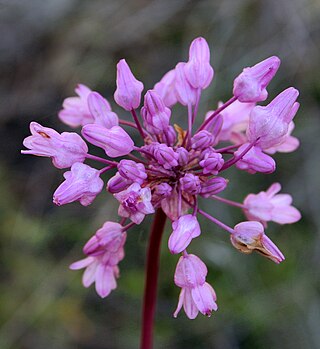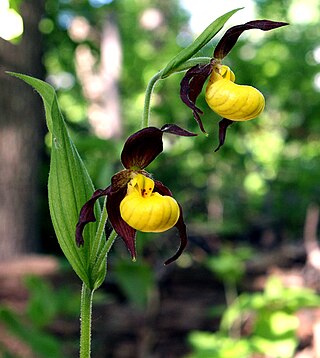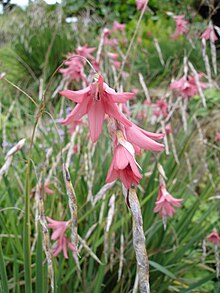
Trillium is a genus of about fifty flowering plant species in the family Melanthiaceae. Trillium species are native to temperate regions of North America and Asia, with the greatest diversity of species found in the southern Appalachian Mountains in the southeastern United States.

Dendrobium is a genus of mostly epiphytic and lithophytic orchids in the family Orchidaceae. It is a very large genus, containing more than 1,800 species that are found in diverse habitats throughout much of south, east and southeast Asia, including China, Japan, India, the Philippines, Indonesia, Australia, New Guinea, Vietnam and many of the islands of the Pacific. Orchids in this genus have roots that creep over the surface of trees or rocks, rarely having their roots in soil. Up to six leaves develop in a tuft at the tip of a shoot and from one to a large number of flowers are arranged along an unbranched flowering stem. Several attempts have been made to separate Dendrobium into smaller genera, but most have not been accepted by the World Checklist of Selected Plant Families.

Lactuca, commonly known as lettuce, is a genus of flowering plants in the family Asteraceae. The genus includes at least 50 species, distributed worldwide, but mainly in temperate Eurasia.

Dichelostemma is a genus of North American plants closely related to the genus Brodiaea and sometimes regarded as part of that group.

Drakaea is a genus of 10 species in the plant family Orchidaceae commonly known as hammer orchids. All ten species only occur in the south-west of Western Australia. Hammer orchids are characterised by an insectoid labellum that is attached to a narrow, hinged stem, which holds it aloft. The stem can only hinge backwards, where the broadly winged column carries the pollen and stigma. Each species of hammer orchid is pollinated by a specific species of thynnid wasp. Thynnid wasps are unusual in that the female is flightless and mating occurs when the male carries a female away to a source of food. The labellum of the orchid resembles a female thynnid wasp in shape, colour and scent. Insect pollination involving sexual attraction is common in orchids but the interaction between the male thynnid wasp and the hammer orchid is unique in that it involves the insect trying to fly away with a part of the flower.

Gladiolus angustus is a species of gladiolus known by the common name long-tubed painted lady. It is native to the Cape Provinces of South Africa.

Dipodium, commonly known as hyacinth orchids, is a genus of about forty species of orchids native to tropical, subtropical and temperate regions of south-east Asia, New Guinea, the Pacific Islands and Australia. It includes both terrestrial and climbing species, some with leaves and some leafless, but all with large, often colourful flowers on tall flowering stems. It is the only genus of its alliance, Dipodium.

Gladiolus italicus is a species of gladiolus known by the common names Italian gladiolus, field gladiolus, and common sword-lily. It is native to much of Eurasia and North Africa, but it is well known on other continents where it is a common weed, particularly of cultivated fields and waste places. This perennial flower grows an erect stem approaching a meter in maximum height with a few long leaves around its base. Toward the top half of the generally unbranching stem is a spike inflorescence on which flowers appear at intervals. Each plant has up to 15 or 16 flowers. The flower is bright pink to magenta and several centimeters long with its stamens and style protruding from the throat. The fruit is a capsule about a centimeter long containing many seeds.

Cypripedium parviflorum, commonly known as yellow lady's slipper or moccasin flower, is a lady's slipper orchid native to North America. It is widespread, ranging from Alaska south to Arizona and Georgia. It grows in fens, wetlands, shorelines, and damp woodlands.
Olive Mary Hilliard was a South African botanist and taxonomist. Hilliard authored 372 land plant species names, the fifth-highest number of such names authored by any female scientist.

Trillium albidum is a species of flowering plant in the bunchflower family Melanthiaceae. It is the only trillium characterized by a stalkless white flower. The species is endemic to the western United States, ranging from central California through Oregon to southwestern Washington. In the San Francisco Bay Area, it is often confused with a white-flowered form of Trillium chloropetalum. In northern Oregon and southwestern Washington, it has a smaller, less conspicuous flower.

Freesia alba is a species of flowering plant in the iris family. Some sources consider it to be a subspecies of Freesia leichtlinii, F. leichtlinii subsp. alba. It is native to the Cape Provinces of South Africa, but this species and hybrids are known on other continents where they have been introduced. Freesia alba is an herbaceous perennial growing from a corm and producing an erect, often branched stem up to 40 cm (16 in) centimeters tall with several leaves up to about 15 centimeters long. The inflorescence is a spike of several fragrant flowers with usually white tepals marked with yellow and purple.
Oryzidium is a genus of African plants in the grass family.

Dierama pendulum, commonly known as fairy bell, hair bell and wedding bell, is a species of Iridaceae endemic to the Eastern Cape in South Africa and first collected in 1772 by the Swedish naturalist Carl Peter Thunberg near Essenbos on the Kromme River or Kromrivier which flows down the Langkloof. In 1845 the genus Dierama was established by Karl Koch (1809-1879) based on this specimen. Before that the plant had been placed in various genera including Ixia, Sparaxis and Watsonia. The species name has been misapplied to D. inyangense, D. densiflorum and to D. plowesii.

Dierama pulcherrimum, angel's fishing rod, is a species of flowering plant in the iris family Iridaceae, native to South Africa. Growing to 1.5 m (4.9 ft) tall by 0.5 m (1.6 ft) broad, it is an arching evergreen perennial with drooping rosy pink bell-shaped flowers in summer.

Tinnea (sunbells) is a genus of plants in the family Lamiaceae first described in 1867. It is native to sub-Saharan Africa. It was named in honour of the Dutch explorer Alexine Tinne.
- Tinnea aethiopicaKotschy ex Hook.f. - widespread from Mali to Somalia south to Mozambique; naturalized in Trinidad & Tobago
- Tinnea antiscorbuticaWelw. - DRC, Zambia, Angola
- Tinnea apiculataRobyns & Lebrun - eastern Africa from Rwanda to Mozambique
- Tinnea barbataVollesen - Eswatini, northern South Africa
- Tinnea barteriGürke - western Africa
- Tinnea benguellensisGürke - Angola
- Tinnea coeruleaGürke - DRC, Zambia, Angola
- Tinnea eriocalyxWelw. - DRC, Angola, Botswana, Namibia
- Tinnea galpiniiBriq. - Eswatini, Mozambique, South Africa
- Tinnea gossweileriRobyns & Lebrun - Angola
- Tinnea gracilisGürke - Tanzania to Zambia
- Tinnea mirabilis(Bullock) Vollesen - Tanzania
- Tinnea physalisE.A.Bruce - Tanzania
- Tinnea platyphyllaBriq. - DRC
- Tinnea rhodesianaS.Moore - South Africa, Namibia, Zimbabwe, Zambia, Angola, Mozambique
- Tinnea somalensisGürke ex Chiov. - Ethiopia
- Tinnea vesiculosaGürke - Tanzania, Malawi
- Tinnea vestitaBaker - Zimbabwe, Zambia, Angola, Botswana
- Tinnea zambesiacaBaker - Zimbabwe, Zambia, Malawi, Mozambique
Fuerstia is a genus of plants in the family Lamiaceae, first described in 1929. It is native to Eastern and Southern Africa.
- Fuerstia adpressaA.J.Paton - Angola
- Fuerstia africanaT.C.E.Fr. - East Africa
- Fuerstia angustifoliaG.Taylor - Tanzania, Angola, Malawi, Zambia
- Fuerstia bartsioides(Baker) G.Taylor - South Sudan
- Fuerstia dendrothrixA.J.Paton - Somalia
- Fuerstia raraG.Taylor - Angola
- Fuerstia rigida(Benth.) A.J.Paton - Angola
- Fuerstia ternataA.J.Paton - Tanzania
- Fuerstia welwitschiiG.Taylor - Angola
Kabuyea is a plant genus in the family Tecophilaeaceae, first described as a genus in 1998. It has one known species, Kabuyea hostifolia, native to Tanzania and Mozambique.
Plants of the World Online (POWO) is an online database published by the Royal Botanic Gardens, Kew. It was launched in March 2017 with the ultimate aim being "to enable users to access information on all the world's known seed-bearing plants by 2020". The initial focus was on tropical African Floras, particularly Flora Zambesiaca, Flora of West Tropical Africa and Flora of Tropical East Africa.

Hewittia malabarica is a flowering plant in the monotypic genus HewittiaWight & Arn., belonging to the family Convolvulaceae and widespread throughout tropical Africa, Asia, and Polynesia. It is a climbing or prostrate perennial herb with slender stems and flowers that are pale yellow, cream, or white with a purple center, and large leaves that can be used as a cooked vegetable or used in folk medicine with the roots. The stems can be used to make ropes.


















